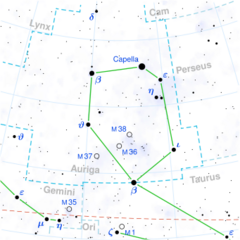Astronomy:Psi1 Aurigae
| Observation data Equinox J2000.0]] (ICRS) | |
|---|---|
| Constellation | Auriga |
| Right ascension | 06h 24m 53.90155s[1] |
| Declination | +49° 17′ 16.4112″[1] |
| Apparent magnitude (V) | 4.91[2] |
| Characteristics | |
| Spectral type | K5-M1Iab-Ib[3] |
| U−B color index | +2.29[2] |
| B−V color index | +1.97[2] |
| R−I color index | 1.07 |
| Variable type | LC[4] |
| Astrometry | |
| Radial velocity (Rv) | +4.7[5] km/s |
| Proper motion (μ) | RA: –0.155[1] mas/yr Dec.: –2.131[1] mas/yr |
| Parallax (π) | 0.4426 ± 0.1103[1] mas |
| Distance | approx. 7,000 ly (approx. 2,300 pc) |
| Absolute magnitude (MV) | −5.53[6] |
| Details | |
| Mass | 14.4 ± 0.8[7] M☉ |
| Radius | 726[8] R☉ |
| Luminosity | 63,579[9] L☉ |
| Temperature | 3,750[10] K |
| Metallicity [Fe/H] | +0.08[11] dex |
| Age | 12.3 ± 0.4[7] Myr |
| Other designations | |
| Database references | |
| SIMBAD | data |
Psi1 Aurigae (ψ1 Aur, ψ1 Aurigae) is a star in the northern constellation of Auriga. It is faintly visible to the naked eye with an apparent visual magnitude of 4.91.[2] Based upon a measured annual parallax shift of 0.44 mas,[1] it is approximately 7,500 light-years (2,300 parsecs) distant from the Earth. It is receding from the Sun with a radial velocity of +4.7 km/s.[5]

This is a massive supergiant star with a stellar classification of K5-M1Iab-Ib.[3] It is a slow irregular variable of the LC type, with its brightness varying in magnitude by 0.44.[4] The star is more than 14[7] times as massive as the Sun and is blazing with 63,579[9] times the Sun's luminosity. This energy is being radiated into outer space from its outer atmosphere at an effective temperature of 3,750 K,[10] giving it the orange-red hue of a cool M-type star.
See also
References
- ↑ Jump up to: 1.0 1.1 1.2 1.3 1.4 1.5 Vallenari, A. et al. (2022). "Gaia Data Release 3. Summary of the content and survey properties". Astronomy & Astrophysics. doi:10.1051/0004-6361/202243940 Gaia DR3 record for this source at VizieR.
- ↑ Jump up to: 2.0 2.1 2.2 2.3 Nicolet, B. (1978), "Photoelectric photometric Catalogue of homogeneous measurements in the UBV System", Astronomy and Astrophysics Supplement Series 34: 1–49, Bibcode: 1978A&AS...34....1N.
- ↑ Jump up to: 3.0 3.1 Keenan, Philip C.; McNeil, Raymond C. (1989), "The Perkins Catalog of Revised MK Types for the Cooler Stars", The Astrophysical Journal Supplement Series 71: 245, doi:10.1086/191373, Bibcode: 1989ApJS...71..245K.
- ↑ Jump up to: 4.0 4.1 Adelman, Saul J. (2001), "Stars with the Largest Hipparcos Photometric Amplitudes", Baltic Astronomy 10 (4): 589–593, doi:10.1515/astro-2001-0403, Bibcode: 2001BaltA..10..589A.
- ↑ Jump up to: 5.0 5.1 Wielen, R. et al. (1999), "Sixth Catalogue of Fundamental Stars (FK6). Part I. Basic fundamental stars with direct solutions", Veroeffentlichungen des Astronomischen Rechen-Instituts Heidelberg (Astronomisches Rechen-Institut Heidelberg) 35 (35): 1, Bibcode: 1999VeARI..35....1W.
- ↑ Schiavon, Ricardo P. (July 2007), "Population Synthesis in the Blue. IV. Accurate Model Predictions for Lick Indices and UBV Colors in Single Stellar Populations", The Astrophysical Journal Supplement Series 171 (1): 146–205, doi:10.1086/511753, Bibcode: 2007ApJS..171..146S.
- ↑ Jump up to: 7.0 7.1 7.2 Tetzlaff, N.; Neuhäuser, R.; Hohle, M. M. (January 2011), "A catalogue of young runaway Hipparcos stars within 3 kpc from the Sun", Monthly Notices of the Royal Astronomical Society 410 (1): 190–200, doi:10.1111/j.1365-2966.2010.17434.x, Bibcode: 2011MNRAS.410..190T.
- ↑ Stassun K.G. (October 2019), "The revised TESS Input Catalog and Candidate Target List", The Astronomical Journal 158 (4): 138, doi:10.3847/1538-3881/ab3467, Bibcode: 2019AJ....158..138S.
- ↑ Jump up to: 9.0 9.1 Hohle, M. M.; Neuhäuser, R.; Schutz, B. F. (April 2010), "Masses and luminosities of O- and B-type stars and red supergiants", Astronomische Nachrichten 331 (4): 349, doi:10.1002/asna.200911355, Bibcode: 2010AN....331..349H.
- ↑ Jump up to: 10.0 10.1 Levesque, Emily M. et al. (August 2005), "The Effective Temperature Scale of Galactic Red Supergiants: Cool, but Not As Cool As We Thought", The Astrophysical Journal 628 (2): 973–985, doi:10.1086/430901, Bibcode: 2005ApJ...628..973L.
- ↑ Bakos, Gustav A. (October 1971), "Abundances of Heavy Elements in Late-Type Stars", Journal of the Royal Astronomical Society of Canada 65: 222, Bibcode: 1971JRASC..65..222B.
- ↑ "psi01 Aur". SIMBAD. Centre de données astronomiques de Strasbourg. http://simbad.u-strasbg.fr/simbad/sim-basic?Ident=psi01+Aur.
- ↑ Percy, John R.; Wilson, Joseph B.; Henry, Gregory W. (August 2001), "Long-Term VRI Photometry of Small-Amplitude Red Variables. I. Light Curves and Periods", Publications of the Astronomical Society of the Pacific 113 (786): 983–996, doi:10.1086/322153, Bibcode: 2001PASP..113..983P.
External links
 |


